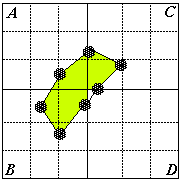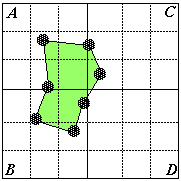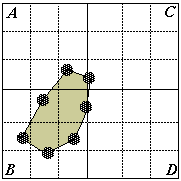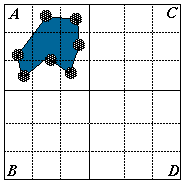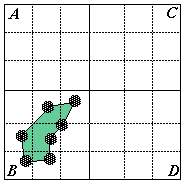|
navigation
consulting
services
training
services
specials
reading
material
resources
|
In our short industrial history we can identify 4 main models of industrial enterprises in respect of their overall organisational strategy. To make a simple scheme we consider two main parameters:
- The INTERNAL ORGANISATION
- The RELATIONSHIP WITH THE MARKET
INTERNAL ORGANISATION: historically, we can identify two main (extreme) approaches:
- product/organisation oriented
[The main attention is to the product (or service) - The Organisation is seen as a tool to produce products or services - The Organisation is well structured (functions, duties, responsibilities, authorities) - Activities are rational, logic, systematic, standardised - Bureaucracy is alive and kicking - People Motivation: medium/low]
- process/people oriented
[The main attention is to the business process and to people (groups) managing/involved in processes -
The Organisation is more flexible, with an "entrepreneurial" type of management and activities - This is a Group-oriented, "Learning Organisation" - There is little bureaucracy or none at all - People Motivation: high ]
RELATIONSHIP WITH MARKET: historically, we can identify two main (extreme) approaches:
- operations oriented
[The Market is seen in the background, or anyhow "far" - Reactions to Market's changes consist, mainly, of change/improvement of "technology" and/or change/improvement of product/s - The strength is "Know-how" (Product - Technology)]
- market oriented
[The Market is "in" the Enterprise - The Market and Market changes are detected and analysed - The tendency is to define Market's needs and localise opportunities - The strength is in the ability to reap & manage opportunities]
By combining the 4 main "approaches" we find the 4 main industrial models:
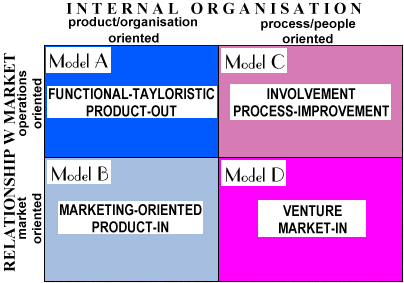
- Model A: FUNCTIONAL-TAYLORISTIC - PRODUCT-OUT
This is the industrial Model typical of the years 50s - 60s in the West.
It is product/organisation oriented and operations oriented. It's the paleo-enterprise. Its doors are closed. They are opened only to deliver product to the market. As demand exceeds supply, the Market is unsaturated, static, well predictable.
The Model is called FUNCTIONAL-TAYLORISTIC because is based on functions and on Taylor's Scientific Organisational System.
It's called PRODUCT-OUT because the main concern of this model of enterprise is to produce enough product to satisfy demand.
- Model B: MARKETING-ORIENTED - PRODUCT-IN
This is the industrial Model typical of the years 60s - 70s in the West.
It is product/organisation oriented but market oriented. It's the "Marketing" Enterprise, that starts seeing a "saturated" Market and changes in the Market. Consequently it opens the door and goes out for a walk in the Market, to see what is happening, and decide accordingly.
For this very reason this Model is called MARKETING-ORIENTED. It's called also PRODUCT-IN because it's now the feed-back from the Market analysis that contributes to decide about what to offer to the Market.
- Model C: INVOLVEMENT - PROCESS-IMROVEMENT
This is the Industrial Model typical of the late 70s - 80s in the East (Japan).
It is operations oriented and process/people oriented. This is the Improving Enterprise, the enterprise that understands the primary importance of processes and people in processes.
However, its relationship with the market is still old-style. The main attention is to the operations that produce a competitive product, competitive in terms of quality, cost and time-to-market.
The market is there, a bit "blurred" in the background. The market exists, created by the (western) competition. The target is to beat the competition through "superior" operations.
This is the Just-in-Time era, with a strong support by TPM - Total Productive Maintenance (more »), TQM - Total Quality Management (more »), QFD - Quality Function Deployment (more ») and TEI - Total Employee Involvement (more »).
The Model is called Involvement - Process-Improvement because it is through high involvement of people that processes (mainly operational processes) are improved, kaizen style.
- Model D: VENTURE - MARKET-IN
This is the world-class Industrial Model, structured mainly in the West and diffused world-wide, starting from late 80s - 90s.
It is market oriented and process/people oriented. This is the world-class Enterprise, the enterprise that lets "pull" all its processes by the Market, and perfects them to high levels of value generation. Its approach to the Market is "new-world" as it is its approach to process management.
This is the VAM - Value Adding Management (more ») era, where VAM is deployed and applied via lean approaches. Lean Manufacturing (more »), Lean Project Management (more ») and Process Engineering (more ») are typical of this era.
The Model is called Venture because of the "entrepreneurial" style of process management. It is called Market-in because the enterprise's doors are fully open and in direct communication with the Market, that literally "invades" the enterprise.
As already said, the above classification is based on "extremes".
Thus, the 4 "ideal" models described would fall on the respective outer corners of the grid.
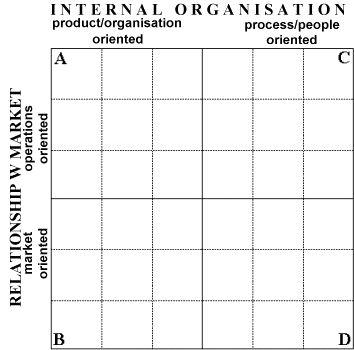
In reality, enterprises are living "organism", in a delicate equilibrium of people, methods, technology, culture, policies......
An enterprise wishing to understand to which "Organisational Strategies" Model it belongs should consider many areas and "scan" and assess many areas. Suitable questionnaires are available for the purpose.
At least the following "areas" should be considered:
- The INDUSTRIAL CULTURE area
- The RELATIONSHIP WITH THE MARKET area
- The RELATIONSHIP WITH CLIENTS area
- The MANAGEMENT AND GENERAL ORGANISATION area
- The RELATIONSHIP WITH EMPLOYEES area
- The OPERATIONAL STRATEGIES/PRACTICES area
- The RELATIONSHIP WITH SUPPLIERS area
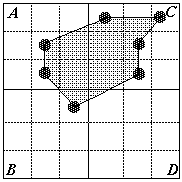 By considering, for each area, several "features" typical of the 4 "extreme" Models - and by comparison and simple interpolation - an overall "score" representative of each area is obtained and marked on the grid.
By considering, for each area, several "features" typical of the 4 "extreme" Models - and by comparison and simple interpolation - an overall "score" representative of each area is obtained and marked on the grid.
The resulting "shape" is just an indication of where an enterprise is positioned with regard to its Organisational Strategies, in respect of the 4 ideal, "extreme" Industrial Models.
So, it has a limited value. But the thinking process associated with the exercise is invaluable. By carrying out the "scanning" assignment, enterprise's key people start visualising where they are, where they sit, ad what are the implications of the resulting "positioning".
Many output "shapes" are possible. Generally, the resulting shape is a mixture of 2 and even 3 Models, a hybrid Organisational situation.
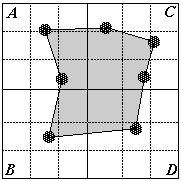 Only in rare instances one finds in an enterprise very atypical organisational features (like, for instance, features of all 4 extreme Models, scattered over the 4 quadrants of the grid, and close to the outer corners). In such cases, either the scanning exercise has been mis-interpreted, or the enterprise belongs to a rare species.....
Only in rare instances one finds in an enterprise very atypical organisational features (like, for instance, features of all 4 extreme Models, scattered over the 4 quadrants of the grid, and close to the outer corners). In such cases, either the scanning exercise has been mis-interpreted, or the enterprise belongs to a rare species.....
In the majority of cases, "traditional" enterprises show features of Model B, with a feature or two of Model C and possibly a feature or two of Model A. But the overall shape is rather "central" in the grid.
Only few "traditional" enterprises show Model-specific features. Their Organisational Strategies "shape" is well positioned within a quadrant:
"World-class" enterprises show well "condensed" shapes, positioned in quadrant 4 or 3 and 4:
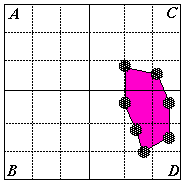 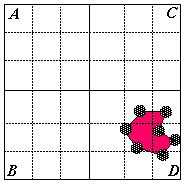
With the proviso that a "scanning" exercise of this nature can only supply an "indication", the tool can still be very useful.
Enterprises still "traditional" in their Organisational Structure can have a good "thumb-suck" indication of the "gap" to be filled to jump to quadrant 4 (possibly "via" quadrant 3.....).
Besides, enterprises can understand in a simple/easy way how "hybrid" is their present status. A very hybrid situation is not potentially fit to make a jump to upper levels. A rather hybrid situation can instead be changed into a more homogeneous shape, before making jumping exercises.
Finally, the "scanning" tool can be perfected. By increasing the number of areas under scrutiny and the zoom-in level, this tool can produce rather valid and rational results.
Knowing where an enterprise is situated with its Organisational Structure can be extremely helpful in defining/perfecting also the enterprise's Human Resources Management strategy, core point in any performance improvement initiative.
(more »)
|




